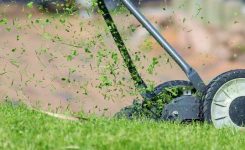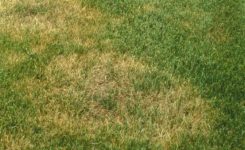Lawn Care Services, Lawn Treatment Solutions Blog
When Should I Dethatch My Warm-Season Lawn?
This is a frequently asked question that we’ll answer in this article.
What is thatch?
Thatch is dense plant matter at the base of the grass. The dead brown growth on dormant warm-season lawns during winter may become part of the thatch unless it is removed. Under certain conditions, thatch builds up over time and prevents water, nutrients, and air from reaching the roots of the grass. When these essentials cannot reach the roots efficiently, the health and density of the grass may suffer. Excessive thatch also increases the risk for disease and pest problems. Managing thatch throughout the growing season will help keep your lawn healthy.
Should I dethatch in the early spring?
Hand raking or mechanically dethatching your warm-season lawn isn’t necessary and may cause weed problems. Hand raking or mechanically dethatching disturbs the preemergent barrier that was created from the first lawn treatment of the year. The preemergent barrier prevents certain weeds from growing. Disturbing it can result in more weeds.
Simply mow your warm-season lawn low. Bag and remove the clippings if possible. Removing most of the plant matter by mowing low has the added benefit of enabling the new green growth to appear sooner.
If your grass grew a little too high during the growing season last year, the best way to deal with it is to cut the lawn low while it is dormant. If you have more than about 1½ – 2 inches of dead growth in early spring, then cut the lawn to about one inch or as low as possible without cutting into the ground. Cutting very low during dormancy won’t hurt the grass because the plant life is in the root system (i.e., the brown grass you can see is dead).
Is it best to cut the lawn low during dormancy or after it greens up?
It is not advisable to wait until new green grass has emerged from the soil to cut the lawn very low. A healthy lawn can recover from scalping while it is growing. However, this is not ideal. It is better for your lawn to cut it low before new growth emerges.
Should I dethatch in the fall?
An alternative to cutting your warm-season lawn low in late winter is to do it after the lawn goes dormant in late fall. This will also reduce tracking of dead brittle grass into the house during winter.
How can I minimize thatch throughout the growing season?
For your warm-season lawn, mowing weekly at 1½ – 2 inches during the growing season will manage thatch to the point where normal microbial activity in the soil should adequately decompose the dead plant matter and dethatching won’t be necessary.
Warm-season lawns are prone to thatch buildup when the lawn is overfertilized or is not cut at the proper height and frequency during the growing season. Routinely mowing warm-season grasses high or cutting more than about 1/3 of the blade at once may lead to thatch build-up that natural processes can’t keep up with.
How does Crownover Green help to manage thatch?
Our approach to managing thatch is to prevent excessive growth through proper fertilization, increase microbial activity by applying biological stimulants, and core aerate the lawn in late spring after the highest threat of weed seed germination has passed. We also provide science-based recommendations to our customers on proper mowing height and frequency. Managing thatch throughout the growing season will help keep your lawn healthy.








